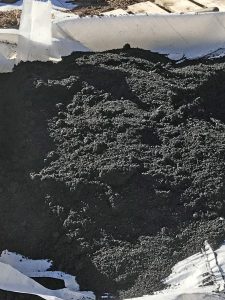
Biochar in preparation as a soil amendment. USDA Forest Service photo by Deborah Page-Dumroese posted on Wikipedia .
——-
Kudos are due to oft-outspoken Robin Wilbur of Elmsdale Lumber for his seriously pursuing production of biochar from wood chips and low-grade wood, as reported by CBC: How biochar could be good business for N.S. lumber company Michael Gorman · CBC News Dec 27, 2020:
Elmsdale Lumber wants to rezone some of its property to make way for the construction of a biochar facility.
The process uses wood chips to create a type of organic charcoal using a process called pyrolysis, or heating the chips at extreme temperatures without oxygen.
“This technology from Europe came to us, we listened to a presentation and our team kind of looked at each other and said, ‘Well, why would we not look into this,'” company president Robin Wilber said in a recent interview.
The company has been exploring new opportunities for wood chips and low-grade wood since Northern Pulp, the largest consumer of such products in Nova Scotia, shut down a little less than a year ago. Wilber said it would augment other markets for chips, such as pellet production.
Biochar has been shown to attract and hold on to moisture and nutrients in soil, meaning crops can be grown with less water and fertilizer. It also has the ability to neutralize soil acidity and remove heavy metals, making it an attractive product for agriculture and remediation work.
I was surprised not to see cited in that article a property of biochar that is usually cited as the biggest environmental benefit: it breaks down very slowly, and locks up carbon “on a centennial scale“. Thus production of biochar from chips reduces carbon emissions rather than increases them as chips/low-grade wood going into forest bioenergy is prone to do.
Indeed, diverting a portion of the forest bioenergy stream to biochar production can make carbon-emitting biomass schemes genuinely carbon neutral or better (as I commented in a submission to the Wheller Process of 2009, at the same time noting that there were no plans to produce biochar on the horizon).
To assess the potential of Mr. Wilbur’s biochar for carbon sequestration and put a monetary value on it or to gain GHG reduction credits for NS, we would need comprehensive, rigorous and transparent forest carbon accounting for NS. Except for the transparent part, that could be going on or under development behind closed doors at L&F. In 2018, L&F hired a “carbon modeller” but there has been no mention of any carbon modelling at L&F in the interim, even in relation to the Small Scale Wood Energy Initiative.

Curved arrows represent biologically mediated flows of GHGs: the straight arrow, industrial emissions of GHGs; and the symbols at bottom right, long term sequestration of carbon in the oceans. Carbon dioxide is the most important GHG in relation to forestry.
Carbon modelling/carbon accounting could be a two edged sword for sawmills. It would probably show that diverting a significant proportion of chips/low grade-wood to biochar production can significantly improve the carbon balance of forestry operations compared to no production of biochar, providing good PR for the products.
However, it might also show that the surge of harvesting of mature forest in NS stimulated by high lumber prices is seriously reducing forest carbon sequestration (not to mention its impacts on soil acidification and wildlife) and lead to more pressure to reduce such harvesting, at least on Crown lands.
Sooner or later, the “creative accounting” that has allowed Canada to push its true forestry carbon debt into the future will come home to roost and then competing interests will demand more honest and comprehensive carbon accounting. I just hope it is not after we have cut down most of our remaining old, high volume forests.
Regardless, the possibility of a significant portion of the chip/low-grade wood stream going to biochar production in NS is good news, and I wish Mr. Wilber well in his new endeavour.
Tip of the hat to Nancy R for alerting me to the CBC biochar article
———-
View discussion of this post on WWNS
Some Related Posts on NSFN
Canada’s faulty forest carbon accounting laid bare 30Mar2020
Posted on March 30, 2020
In 2020, strict standards and transparency are required for Nova Scotia’s forest chipping/bioenergy projects to be credible as “good for the environment” 11Feb2020
Posted on February 11, 2020
Time for Nova Scotia Government to come clean on forest bioenergy feedstocks 19Mar2019
Posted on March 19, 2019
Also relevant:
Petition to the Securities and Exchange Commission (SEC) to issue guidance under regulation S-K regarding how companies should disclose information about emissions ofgreenhouse gases from manufacturing and use of biomass-based fuels and products
Feb 27, 2019. Detailed, referenced document. “Re: Request for guidance to ensure that issuers manufacturing and using biomass-based fuels and products engage in comparable disclosures regarding greenhouse gas emissions that are informative to investors and not materially misleading.” Cites issues with biochar amongst the financial scams that have occurred. Popular account: Accurate Reporting Of Biofuels’ Impact Needed, In the Financial Advisor, Feb 27, 2019. “The Partnership for Policy Integrity, an environmental group based in Pelham, Mass., which focuses on the impact of production and use of bio-fuels, filed a petition with the Securities and Exchange Commission Wednesday asking for guidelines on reporting on the environmental impact of substitutes for fossil fuels.”
